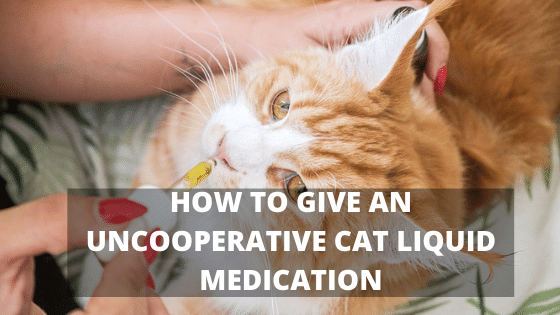Cats are cute and lovable creatures. Just like us, they also suffer from a number of health-related conditions. To treat ailments in cats, a wide range of medications are used. Medications are available in different forms (liquid, pills, semi-solid) and there are many ways of introducing them to a cat’s body (routes of administration).
Seldom, medication giving process becomes challenging for the vets/health care experts because of the vicious/uncooperative temperament of the cat.
Here, we will discuss some important techniques to give medication to uncooperative cats.
HOW TO GIVE AN UNCOOPERATIVE CAT LIQUID MEDICATION
There are many methods which can be when giving an uncooperative cat liquid medication. Suitable restraining techniques should be adopted depending upon the situation.
PLACING CAT IN LAP
This is a nice method to calm down an uncooperative cat. Gently approach the cat. Hold her in your lap. This is better to place the cat between legs and to stroke her head (it will help in reducing the aggression and defensive behavior). Remember, a cat can be easily held and managed when she is in your lap.
Administer the liquid medicine with the help of a syringe. This has also been observed that cats become curious when they see syringes and will take one or two licks.
According to experts point of view,, this is a good idea to give one or two licks to an uncooperative cat. Let her approach the syringe and taste what you are going to give her. Simply, when a cat comes to lick, gently administer the liquid medication with proper care and expertise.
USE OF CAT FRIENDLY SYRINGE
As you know, it is preferable to administer liquid medication through a syringe. Choice is syringe is a very critical thing. This is a better idea to choose a soft tipped, cat friendly syringe.
This technique is safe, quite simple and gives better outcomes. Remember, administration of the exact dose of liquid medication is very crucial. This only becomes possible through syringe (you can give your cat an exact dose). Again, proper restraining technique should be adopted to limit the movement/aggression of an uncooperative cat.
Drenching pneumonia:
It is very important to highlight the concept of drenching pneumonia here. This condition basically occurs when liquid medication mistakenly reaches in the windpipe (trachea) and further moves to lungs causing respiratory complications there. Drenching pneumonia can be life threatening.
So, you must be careful while giving liquid medication to a cat (especially uncooperative one). Don’t make attempts to forcefully administer the medication. Always go for a safe and wise procedure.
MAKE CAT FEEL SAFE:
GAINING CAT’S TRUST IS AN IMPORTANT KEY THAT UNLOCKS HER SENSE TO FEEL SECURE
Uncooperative cats show resistance and aggression. They don’t let the vet/owner give them medication that easy. Being a responsible owner/vet, this is your duty to make an uncooperative cat feed secure. Wrap the blanket around her ( on which she usually sleeps). This blanket will mentally and physically soothe her . The cat will feel comfortable.
Once you have gained her confidence, go for the safe administration of liquid medication.
AWARD TREATS TO AN UNCOOPERATIVE CAT
This is a general experience that cats love to be awarded. Additionally, they remember the positive experiences. It is recommended that treat awarding helps in making an uncooperative cat feel happy. Always give treats after administering a dose of liquid medication.
However, in some cases, it has also been observed that vets/owners give liquid medications by mixing them in the cat’s diet. Generally, this method is adopted while dealing with an uncooperative cat. Remember, there are many disadvantages of this technique.
The major one is improper intake of diet, hence medication. Desirable amount of liquid medication (dose) can’t reach the affected system. This is why it becomes impossible to get desired pharmacological responses (positive results) due to less bioavailability of medication.
IMPORTANT RECOMMENDATIONS
1) Approach an uncooperative cat from the side. Don’t directly put your fingers in her mouth (she may bite you).
2) Always use liquid medication at room temperature (cats easily accept the warm medications). Train an uncooperative cat to take medication gradually.
3) Always hold the syringe with your dominant hand. On the other hand, properly hold the cat.
4) Provide a stress free and safe environment to an uncooperative cat while giving liquid medication.
5) Properly read the instructions present on the label of that particular medication. Slowly administer the medication (make sure that cat is swallowing it). If she throws it out, again make an attempt but carefully calculate the dose. This is a possibility that might be because she has swallowed some portion of medication.

